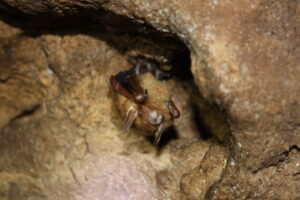By Kelly Vowels

Bats use reflected sound or echolocation to navigate and hunt. Since 2014, thanks to the use of special ultrasonic detection equipment, the Bernheim team has used acoustic monitoring to study the diversity and habitat preference of these amazing creatures. Through this research we have identified 13 species of bats at Bernheim in a wide range of habitats from creeks, wildlife ponds, ridgetops, and many others, giving us a glimpse into their lives.
Acoustic monitoring of bats is a valuable research method for several reasons:
- It is less intrusive than mist-netting and cave surveys, as bats are
not handled or disturbed. - It allows for more bats to be surveyed than mist-netting.
- Biologists are often unable to capture bats with mist-netting
due to the rise of white-nose syndrome (WNS) in the eastern United States and the decline of many bat species.
WNS is a disease of cave hibernating bats caused by the fungus, Pseudogymnoascus destructans which causes frequent arousal of hibernating bats, resulting in the depletion of fat reserves.
Because of WNS, the once common little brown bats (M. lucifugus) and northern bats (M. septentrionalis) are now in danger of extinction. Big brown bats (Eptesicus fuscus) have not been as negatively impacted.
To learn more about Bernheim’s ongoing research visit bernheim.org/research.


